Cinderella
| Cinderella | |
|---|---|
| Gustave Doré's illustration for Cendrillon | |
| Folk tale | |
| Name: | Cinderella |
| AKA: | Cendrillon, Cenicienta, Aschenputtel, Cenerentola, Askungen |
| Data | |
| Aarne-Thompson Grouping: | 510a |
| Country: | Worldwide |
| Published in: | The Pentamerone (1634) Mother Goose Tales (1697) Grimm's Fairy Tales (1812) |
"Cinderella; or, The Little Glass Slipper" (French: Cendrillon, ou La petite Pantoufle de Verre) is a classic folk tale embodying a myth-element of unjust oppression/triumphant reward. Thousands of variants are known throughout the world.[1] The title character[2] is a young woman living in unfortunate circumstances that are suddenly changed to remarkable fortune. The word "cinderella" has, by analogy, come to mean one whose attributes are unrecognised, or one who unexpectedly achieves recognition or success after a period of obscurity and neglect. The still-popular story of Cinderella continues to influence popular culture internationally, lending plot elements, allusions, and tropes to a wide variety of media.
Contents |
Early versions
The Cinderella theme may well have originated in classical antiquity. The Greek historian Strabo (Geographica Book 17, 1.33) recorded in the 1st century BC the tale of the Greco-Egyptian girl Rhodopis, "rosy-cheeked", who lived in the Greek colony of Naucratis in Ancient Egypt. It is often considered the oldest known version of the story:
They tell the fabulous story that, when she was bathing, an eagle snatched one of her sandals from her maid and carried it to Memphis; and while the king was administering justice in the open air, the eagle, when it arrived above his head, flung the sandal into his lap; and the king, stirred both by the beautiful shape of the sandal and by the strangeness of the occurrence, sent men in all directions into the country in quest of the woman who wore the sandal; and when she was found in the city of Naucratis, she was brought up to Memphis, became the wife of the king...[3][4]
Herodotus, some five centuries before Strabo, supplied further information about Rhodopis in his Histories, writing that Rhodopis came from Thrace, and was the slave of Iadmon of Samos, and a fellow-slave of Aesop. She was taken to Egypt in the time of Pharaoh Amasis, and freed there for a large sum by Charaxus of Mytilene, brother of Sappho the lyric poet.[5][6]
The story later reappears with Aelian (ca. 175–ca. 235),[7] showing that the Cinderella theme remained popular throughout antiquity.
The magical significance of the pumpkin in the Cinderella story, which has led to the modern expression by someone who desires an early bedtime, 'after midnight, I turn into a pumpkin', might derive from the 1st century comic work of Seneca 'On the Pumpkinification of Claudius', playing on a pun for the word for deification and the word for pumpkin.[8]
Another version of the story, Ye Xian, appeared in Miscellaneous Morsels from Youyang by Tuan Ch'eng-Shih around 860. Here the hardworking and lovely girl befriends a fish, the reincarnation of her mother, who was killed by her stepmother. Ye Xian saves the bones, which are magic, and they help her dress appropriately for a festival. When she loses her slipper after a fast exit, the king finds her and falls in love with her. Another version of the story which is almost similar to the Chinese version exists in the Philippines, the story is known as "Mariang Alimango" (Mary the Crab). In this version, the spirit of her dead mother reincarnates as a crab, hence the title, and serves as her "fairy godmother".
Several different variants of the story appear in the medieval One Thousand and One Nights, also known as the Arabian Nights, including "The Second Shaykh's Story", "The Eldest Lady's Tale" and "Abdallah ibn Fadil and His Brothers", all dealing with the theme of a younger sibling harassed by two jealous elders. In some of these, the siblings are female, while in others they are male. One of the tales, "Judar and His Brethren", departs from the happy endings of previous variants and reworks the plot to give it a tragic ending instead, with the younger brother being poisoned by his elder brothers.[9]
Cenerentola, Cinderella and Aschenputtel
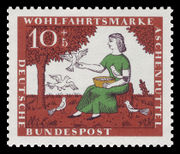
In 1634, Giambattista Basile, a Neopolitan soldier and government official, wrote Lo cunto de li cunti (The Story of Stories), or Pentamerone. It featured the tale of Cenerentola, which features a wicked step mother and step sisters, magical transformations, a missing slipper, and a hunt by a king for the owner of the slipper.[10]
One of the most popular versions of Cinderella was written by Charles Perrault in 1697. The popularity of his tale was due to his additions to the story, including the pumpkin, the fairy-godmother and the introduction of glass slippers.[11]
Another well-known version was recorded by the German brothers Jacob and Wilhelm Grimm in the 19th century. The tale is called "Aschenputtel" ("Cinderella" in English translations) and the help comes not from a fairy-godmother but the wishing tree that grows on her mother's grave. In this version, the stepsisters try to trick the prince by cutting off parts of their feet in order to get the slipper to fit. The prince is alerted by two pigeons who peck out the stepsisters' eyes, thus sealing their fate as blind beggars for the rest of their lives. In this story, the prince is tricked twice but is spared by the birds. This lowers the Prince's status and he seems less heroic, raising Cinderella's status as a strong-willed individual.[12]
In Scottish Celtic myth/lore, there is a story of Geal, Donn, and Critheanach. The Stepsisters' Celtic equivalents are Geal and Donn, and Cinderella is Critheanach.
Plot (taken from Perrault)
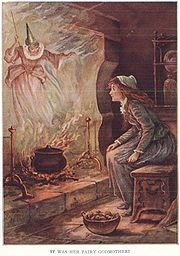
(See above for many variations)
Once there was a widower who married a proud and haughty woman as his second wife. She had two daughters who were equally vain. By his first wife, he'd had a beautiful young daughter who was a girl of unparalleled goodness and sweet temper. The Stepmother and her daughters forced the first daughter to complete all the housework. When the girl had done her work, she sat in the cinders, which caused her to be called "Cinderella". The poor girl bore it patiently, but she dared not tell her father, who would have scolded her; his wife controlled him entirely.
One day the Prince invited all the young ladies in the land to a ball so he could choose a lovely wife. As the two Stepsisters were invited, they gleefully planned their wardrobes. Although Cinderella assisted them and dreamed of going to the dance, they taunted her by saying a maid could never attend a ball.
As the sisters swept away to the ball, Cinderella cried in despair. Her Fairy Godmother magically appeared and vowed to assist Cinderella in attending the ball. She turned a pumpkin into a coach, mice into horses, a rat into a coachman, and lizards into footmen. She then turned Cinderella's rags into a beautiful gown, complete with a delicate pair of glass slippers. The Godmother told her to enjoy the ball, but return before midnight for the spells would be broken.
At the ball, the entire court was entranced by Cinderella, especially the Prince, who never left her side. Unrecognized by her sisters, Cinderella remembered to leave before midnight. Back home, Cinderella graciously thanked her Godmother. She then greeted the Stepsisters who enthusiastically talked of nothing but the beautiful girl at the ball.
When another ball was held the next evening, Cinderella again attended with her Godmother's help. The Prince became even more entranced. However, this evening she lost track of time and left only at the final stroke of midnight, losing one of her glass slippers on the steps of the palace in her haste. The Prince chased her, but outside the palace, the guards had seen only a simple country wench leave. The Prince pocketed the slipper and vowed to find and marry the girl to whom it belonged. Meanwhile, Cinderella kept the other slipper, which had not disappeared when the spell had broken.
The Prince tried the slipper on all the women in the kingdom. When the Prince arrived at Cinderella's villa, the Stepsisters tried in vain. When Cinderella asked if she might try, the Stepsisters taunted her. Naturally, the slipper fitted perfectly, and Cinderella produced the other slipper for good measure. The Stepsisters begged for forgiveness, and Cinderella forgave them for their cruelties.
Cinderella returned to the palace where she married the Prince, and the Stepsisters also married two lords.
The moral of the story is that beauty is a treasure, but graciousness is priceless. Without it nothing is possible; with it, one can do anything.[13]
Types
Folklorists have long studied variants on this tale across cultures.[14] In 1893, Marian Roalfe Cox, commissioned by the Folklore Society of Britain, produced Cinderella: Three Hundred and Forty-Five Variants of Cinderella, Catskin and, Cap o'Rushes, Abstracted and Tabulated with a Discussion of Medieval Analogues and Notes.[14]
Further morphology studies have continued on this seminal work.[14]
Cinderella is classified as Aarne-Thompson type 510A, the persecuted heroine. Others of this type include The Sharp Grey Sheep, The Golden Slipper, The Story of Tam and Cam, Rushen Coatie, Fair, Brown and Trembling and Katie Woodencloak.[15]
Adaptations
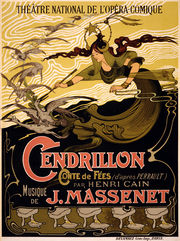
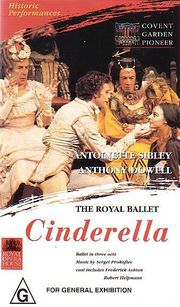
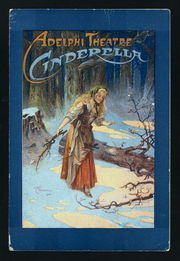
The story of "Cinderella" has formed the basis of many notable works:
Opera
- Cendrillon (1749) by Jean-Louis Laruette
- Cendrillon (1810) by Nicolas Isouard, libretto by Charles-Guillaume Étienne
- La Cenerentola (1817) by Gioachino Rossini
- Cendrillon (1894-5) by Jules Massenet, libretto by Henri Cain
- Cinderella (1901-2) by Gustav Holst
- Cendrillon (1904) by Pauline García-Viardot
- Aschenbrödel (1905) by Leo Blech, libretto by Richard Batka
- La Cenicienta (1966) by Jorge Peña Hen
- Cinderella, a "pantomime opera" (1979) by Peter Maxwell Davies
- Cendrillon, children's opera (1994) by Vladimir Kojoukharov
Ballet
- Cinderella (1893) by Baron Boris Vietinghoff-Scheel
- Aschenbrödel (1901) by Johann Strauss II, adapted and completed by Josef Bayer
- Das Märchen vom Aschenbrödel (1941) by Frank Martin
- Soluschka or Cinderella (1945) by Sergei Prokofiev
- Cinderella (1980) by Paul Reade
Ice Show
- Cinderella (2008) by Tim A. Duncan and Edward Barnwell
Verse
- Assepoester (1981) by Jan Kal
Theater
Pantomime
Cinderella debuted as a pantomime on stage at the Drury Lane Theatre, London in 1904 and at the Adelphi Theatre in London in 1905. Phyllis Dare, aged 14 or 15, starred in the latter.
In the traditional pantomime version the opening scene is set in a forest with a hunt in sway and it is here that Cinderella first meets Prince Charming and his "right-hand man" Dandini, whose name and character come from Gioachino Rossini opera (La Cenerentola). Cinderella mistakes Dandini for the Prince and the Prince for Dandini.
Her father, Baron Hardup, is under the thumb of his two stepdaughters, the Ugly sisters, and has a servant named Buttons, who is Cinderella's friend. Throughout the pantomime, the Baron is continually harassed by the Broker's Men (often named after current politicians) for outstanding rent. The Fairy Godmother must magically create a coach (from a pumpkin), footmen (from mice), a coach driver (from a frog), and a beautiful dress (from rags) for Cinderella to go to the ball. However, she must return by midnight, as it is then that the spell ceases.
Musical Theatre
- Cinderella: The Musical by Landon Parks (Book & Lyrics) and Ioannis Kourtis (music) is an English language musical stage show written in 2009, and based on the opera Cendrillon by Jules Massenett.
- Cinderella by Rodgers and Hammerstein was produced for television three times:
- Cinderella (1957) features Julie Andrews as Cinderella, Jon Cypher, Kaye Ballard, Alice Ghostley and Edie Adams (broadcast in color, but only black-and-white kinescopes exist today).
- Cinderella (1964) features Lesley Ann Warren as Cinderella, Stuart Damon as the Prince, Ginger Rogers as the Queen, Walter Pidgeon as the King, Celeste Holm as the Fairy Godmother and Jo Van Fleet as the Stepmother.
- Cinderella (1997) features Brandy as Cinderella, Paolo Montalban, Whitney Houston, Whoopi Goldberg, Victor Garber, Bernadette Peters, and Jason Alexander.
- The Rodgers and Hammerstein version has also been staged live at times. A successful version ran in 1958 at the London Coliseum with a cast including Tommy Steele, Yana, Jimmy Edwards, Kenneth Williams and Betty Marsden. This version was augmented with several other Rodgers and Hammerstein's songs plus a song written by Tommy Steele, 'You and me' which he sang with Jimmy Edwards. Bobby Howell was the Musical Director. A 2005 version featured Paolo Montalban and an ethnically diverse cast, like the 1997 TV version. Broadway Asia Entertainment produced a staged International Tour starring Lea Salonga and Australian actor Peter Saide in 2008.
- Mr. Cinders, a musical which opened at the Adelphi Theatre, London in 1929. Filmed in 1934
- Into the Woods by Stephen Sondheim (1988), in which Cinderella is one of many fairy tale characters who take part in the plot. This is partly based on the Grimm Brothers version of "Cinderella," including the enchanted birds, mother's grave, three balls, and mutilation and blinding of the stepsisters.
- The Return of The Glass Slipper by Mary Donelly
- Cinderella by Kate Hawley is written in the style of British Pantos.
- Cindy, a 1964 Off-Broadway musical composed by Johnny Brandon
- Золушka (or Zolushka), a 2002 made-for-TV Russian pop musical
- Cinderella (2007), a pantomime written by Stephen Fry for the Old Vic Theatre
- Cinderella Sillyious Musical(2008/09), a musical comedy produced by Ross Petty for the Elgin Theatre Toronto
Plays
- The Ash Girl by Timberlake Wertenbaker
Films
Over the decades, hundreds of films have been made that are either direct adaptations from Cinderella or have plots loosely based on the story. Almost every year at least one, but often several such films are produced and released, resulting in Cinderella becoming a work of literature with one of the largest numbers of film adaptations ascribed to it. It is perhaps rivalled only by the sheer number of films that have been adapted from or based on Bram Stoker's novel Dracula.
- Cinderella (1899), the first ever film version, produced in Germany by Georges Méliès.
- Cinderella (1911), a silent film starring Florence La Badie
- Cinderella (1914), a silent film starring Mary Pickford
- Cinderella, an animated Laugh-O-Gram produced by Walt Disney, first released on December 6, 1922. This film was about 7.5 minutes long.
- Poor Cinderella (1934), a Fleischer Studios animated short film starring Betty Boop
- Cinderella Meets Fella, (1938), a Merrie Melodies animated short film
- Cinderella (Зо́лушка) (1947), a Soviet musical film by Lenfilm studios, starring Erast Garin and Faina Ranevskaya
- Cinderella, an animated feature released on February 15, 1950, now considered one of Disney's classics. A direct-to-video sequel, Cinderella II: Dreams Come True, was released in 2002. A second direct-to-video sequel Cinderella III: A Twist in Time was released in 2007.
- Aschenputtel (1955), West German film, dubbed into English and released in the USA in 1966 as Cinderella.
- The Glass Slipper (1955), feature film with Leslie Caron and Michael Wilding
- Cinderfella (1960), notable in that the main character is a man, played by Jerry Lewis
- Popelka (Cinderella, 1969), a Czech musical film
- Hey, Cinderella! (1970), a 60-minute film produced by the Jim Henson Company. This comedy version features Jim Henson's trademark Muppets (including a small role by Kermit the Frog).
- Sinderella Kül Kedisi (1971) Turkish film with Zeynep Değirmencioğlu
- Tři oříšky pro Popelku / Drei Haselnüsse für Aschenbrödel (Three Nuts for Cinderella; known in the UK as Three Gifts for Cinderella), a Czech-German movie released in 1973
- The Slipper and the Rose, a 1976 British musical film starring Gemma Craven and Richard Chamberlain.
- Cinderella, a 1977 American erotic musical comedy starring Cheryl "Rainbeaux" Smith, Brett Smiley and Sy Richardson, directed by Michael Pataki
- Cindy (1978), made for television
- Zolushka, a 1979 musical Soviet animated film.
- The Tender Tale of Cinderella Penguin (1981), an Oscar-nominated animated short from the National Film Board of Canada[16]
- Fresh_(song) (1985), a music video for the song by Kool & the Gang features a Cinderella theme.
- Hello Kitty's Cinderella (1989), an anime short film starring Hello Kitty, was released in Japan.
- Hello Kitty - Cinderella was released in the U.S. as part of the Hello Kitty and Friends anime series.
- Ashpet: An American Cinderella, a 1990 Southern "Appalachia" version of the story, adapted from the Brothers Grimm, starring Louise Anderson and directed by Tom Davenport.
- If the Shoe Fits (1990), modern take on the Cinderella story set in France starring Rob Lowe and Jennifer Grey
- Cinderella (1994), produced by Jetlag Productions and distributed by GoodTimes Entertainment, premiered on video.
- Cinderella Monogatari (1996) Japanese Anime version of Cinderella. Consisted of 26 episodes.
- Ever After (1998), starring Drew Barrymore
- Cinderella (2000), a British production set in mid-20th century and starring Kathleen Turner
- "Confessions of an Ugly Stepsister (2002), A look at the classic "Cinderella" story from the perspective of one of her 'ugly' stepsister adapted from Gregory Maguire's book of the same name [17]
- A Cinderella Story (2004), a modernization featuring Hilary Duff and Chad Michael Murray
- Cinderelmo, a Cinderella story featuring Sesame Street's Elmo and Keri Russell
- Ella Enchanted (2004), featuring Anne Hathaway, Hugh Dancy, and Aidan McArdle
- Happily N'Ever After (2007)
- Year of the Fish (2008)
- Heart Day, (2009), a Prince rescues a version of Cinderella named Princess Roola
- A segment of the 2005 Turkish anthology film Istanbul Tales made up of five stories based on popular fairy tales is based on this tale in which Cinderella is a prostitute
- Another Cinderella Story (2008) starring Selena Gomez and Drew Seeley
- Elle: A Modern Cinderella Tale (2010) starring Sterling Knight and Ashlee Hewitt
- Cinderella (2013) starring Amanda Seyfried[18]
Books
- Cox M.-R. Cinderella. Three Hundred and Forty-five Variants of Cinderella, Catskin, and Cap 0’ Rushes, abstracted and tabulated, with a discussion of mediaeval analogues, and notes, by Marian Roalfe Cox. L., 1893.
- Rooth A.B. The Cinderella cycle. Lund: Gleerup, 1951.
- 50 Ways To Retell A Story: Cinderella by Alan Peat, Julie Peat and Christopher Storey: Published by Creative Educational Press Ltd 2010. ISBN: 9780954475550
Novels
- Chinese Cinderella by Adeline Yen Mah
- Politically Correct Bedtime Stories by James Garner. In this version, Cinderella is dressed in a gown "woven of silk which was stolen from unsuspecting silkworms" and has all the men fighting to death over her. This enables the women to take over the government and pass the law that women should only wear comfortable clothes.
- Bound by Donna Jo Napoli
- Confessions of an Ugly Stepsister by Gregory Maguire. Maguire's style of writing is to twist fairy tales. In his novel, Cinderella is the spoiled child.
- Ella Enchanted by Gail Carson Levine Ella was put under a spell at birth that forces her to obey any order given to her. An unusual twist as it features the ball only in the last few chapters, dealing more with Ella's struggle against the curse and because the prince (Charmont) knows Ella before the ball but does not recognize her as she is in disguise.
- Cinderellis and the Glass Hill by Gail Carson Levine
- I was a Rat! or The Scarlet Slippers by Philip Pullman
- Bella at Midnight by Diane Stanley
- Just Ella by Margaret Peterson Haddix
- Nine Coaches Waiting by Mary Stewart
- The Glass Slipper by Eleanor Farjeon
- Phoenix and Ashes by Mercedes Lackey
- When Cinderella Falls Down Dead by Joshua Gabe and Grayian Phoenix. In this version, Cinderella is reembodied into the 21st Century in the body of a young girl.
- Witches Abroad by Terry Pratchett
- The Midnight Dancers by Regina Doman makes references to the fairy tale. The heroine Rachel is exploited by her stepmother and stepsisters, and routinely sneaks out to dance.
- Godmother, The Secret Cinderella Story by Carolyn Turgeon. Lil is the fairy that was given the task of helping Cinderella get to the ball and the prince, but she is trapped in the body of an aging eldery woman for the huge mistake she made. To redeem her mistake, she tries to get two single New Yorkers together to a ball.
- Her Feet Chime by Rumki Chowdhury. In this Bangladeshi version, Asha's evil aunt and cousin turn her into a servant, renaming her Thamsha, and breaking all family relations with her. Asha's servant friends help her wear a ginger garment and meet her Nawabzada, Bengali Prince, at a palace gathering.
- Mrs. Beast by Pamela Ditchoff
- Cindy Ella by Robin Palmer
- The Fairy Godmother by Mercedes Lackey
Short Story
- Catch the Moon by Judith Ortiz Cofer
- " Rosie's Dance" by Emma Hardesty
Picture books
- Cinder Edna by Ellen Jackson and Kevin O'Malley. Cinder Edna is Cinderella's next-door neighbor who also has wicked stepsisters and a stepmother, but she cleans birdcages and mows the lawns for neighbors in her spare time. She marries the prince's younger brother who runs an orphanage for kittens, and lives much more "happily ever after" than Cinderella.
- The Egyptian Cinderella by Shirley Climo (combines the Greco-Egyptian story of Rhodopis with everyday life in ancient Egypt)
- The Persian Cinderella by Shirley Climo
- The Turkey Girl: a Zuni Cinderella story, retold by Penny Pollock, illustrated by Ed Young (a native American version)
- Mufaro's Beautiful Daughters by John Steptoe - Set in Zimbabwe
- The Irish Cinderlad
- Yeh-Shen: A Cinderella Story from China by Ai-Ling Louie
- Cinder-Lily
- Sidney Rella and the Glass Sneaker
- Joe Cinders
- Cindy Ellen: A Wild Western Cinderella by Susan Lowell
- Bubba the Cowboy Prince
- Anklet for a Princess
- Cinderella Skeleton
- Cindy Big Hair
- Rufferella
- Bigfoot Cinderrrrrella
- Cinderhazel
- Cinderbear
- Cinderella Bunny
- Rexerella
- Cinder-Elly
- Dinorella by Pamela Duncan Edwards
Comic books
- Cinderella appears as a character in Bill Willingham's Vertigo series, Fables. Cinderella (or "Cindy," as her fellow Fables call her) is the third and final of Prince Charming's ex-wives and is Fabletown's resident super spy. Her cover is the ownership of her own shoe store, the Glass Slipper, and she maintains a bitter persona in order to throw off the suspicions of the rest of her community.
- Cinderalla by Junko Mizuno
- Ludwig Revolution by Kaori Yuki. In this version, Cinderella's feet are too large and the series' protagonist lends her his shoe for the evening, acting as her Fairy Godmother. Also, the Prince doesn't hold the ball to find his wife, but to find the woman with large feet who killed his pet lizard, Isolde.
Songs
Some popular songs that make reference to the story of Cinderella include:
- Cinderella Man by Eminem
- A Cinderella Story Mudvayne
- Cinderella by Britney Spears
- Cendrillon by Miku Hatsune & KAITO
- Romeo and Cinderella by Miku Hatsune
- Cinderella by Steven Curtis Chapman
- Cinderella by The Cheetah Girls
- Cinderella by Vince Gill
- Cinderella by Sweetbox
- Cinderella by Tata Young
- Cinderella Undercover by Oingo Boingo
- Cinderella Blue by Robert Lucas
- Cinderella's Curls by Waxing Gibbous
- Cinderfella by Snoop Dogg
- Cinderella Stay Awhile by Michael Jackson
- A Dustland Fairytale by The Killers in Day & Age
- Fairytale by Sara Bareilles
- Half Past Midnight by 1960's Canadian vocal group The Staccatos
- Hey Cinderella by Suzy Bogguss
- The Glass Slipper by The Dresden Dolls
- Mayonaka no Door, by Liu Yifei (first ending of Demashita! Powerpuff Girls Z)
- Not Your Cinderella by Catherine Britt
- One Headlight by The Wallflowers
- Stealing Cinderella by Chuck Wicks
- There is Music in You by Rodgers & Hammerstein
- Umbrella (Remix), originally by Rihanna & Jay-Z but remixed by Chris Brown and retitled "Cinderella"
- C\C (Cinderella\Complex) by High-King
- Cinderella 신데렐라 by Seo In-Young A Korean Pop Singer
- Cendrillon (The french name for Cinderella) by French rock group Téléphone
- Rindercella by Archie Campbell
- Cinderella by Sajjad Ali
- 21Ji Made no Cinderella by Berryz Koubou
- Hadashi no Cinderella Boy by NewS
- Shi no Butou~Romance of the Cendrillon by Malice Mizer
- Cinderfella Dana Dane by Dana Dane
Cinderella jumprope song
There is a jumprope song for children that involves Cinderella:
Cinderella dressed in yellow, went upstairs to kiss her fellow, by mistake she kissed a snake, how many doctors will it take? 1, 2, 3, etc.
Cinderella dressed in blue, went upstairs to tie her shoe, made a mistake and tied a knot, how many knots will she make? 1, 2, 3, etc.
Cinderella dressed in green, went downtown to buy a ring, made a mistake and bought a fake, how many days before it breaks? 1, 2, 3, etc.
Cinderella dressed in lace, went upstairs to fix her face, oh no oh no, she found a blemish, how many powder puffs till she's finished? 1, 2, 3, etc.
Cinderella dressed in silk, went outside to get some milk, made a mistake and fell in the lake, how many more till she gets a break? 1, 2, 3, etc.
The counting continues as long as the jumper avoids missing a jump. If they do then the counting starts again.
Variations:
Cinderella dressed in yellow, went downtown to meet her fellow (or "to buy some mustard"). On the way, her girdle busted. All the people were disgusted.
(Heard in Jackson Heights, Queens, late 1950s)
Cinderella dressed in yellow, went upstairs to kiss her fellow. how many kisses did she give him?
(Heard in Northern Ireland)
Cinderella dressed in yell'a, went downstairs to kiss a fell'a. Made a mistake and kissed a snake, how many stitches (or "doctors") did it take?"
Video games
In 2005, Disney released Disney's Cinderella: Magical Dreams for the Nintendo Game Boy Advance. Cinderella was also featured in Disney's / Squaresoft's video game Kingdom Hearts[19] where she is one of the seven princesses of heart which are needed to open the door to darkness. She, along with her entire world, will also be in Kingdom Hearts: Birth by Sleep.
See also
- Cinderella effect
- Cinderella complex
Footnotes
- ↑ Zipes, Jack (2001). The Great Fairy Tale Tradition: From Straparola and Basile to the Brothers Grimm. W. W. Norton & Co. p. 444. ISBN 978-0393976366.
- ↑ Although both the story's title and the character's name change in different languages, in English-language folklore "Cinderella" is the archetypal name.
- ↑ Strabo (23). "Strabo's account of Rhodopis". The Geography. http://penelope.uchicago.edu/Thayer/E/Roman/Texts/Strabo/17A3*.html#ref178. Retrieved 25 March 2010.
- ↑ "The Egyptian Cinderella", an embellished retelling.
- ↑ Anderson, Graham (2000). Fairytale in the ancient world. Routledge. p. 27. ISBN 978-0415237024. http://books.google.com/?id=B2DAAlUrbBIC&pg=PA27&dq=Fairytale+in+the+ancient+world+rhodopis&cd=1#v=onepage&q=Fairytale%20in%20the%20ancient%20world%20rhodopis. Retrieved 25 March 2010.
- ↑ Herodotus. The Histories. http://www.perseus.tufts.edu/hopper/searchresults?target=en&inContent=true&q=Rhodopis&doc=Perseus%3Atext%3A1999.01.0126. Retrieved 25 March 2010., book 2, chapters 134 and 135.
- ↑ Aelian, "Various History", 13.33
- ↑ Seneca, Apocolocyntosis Divi Claudii
- ↑ Ulrich Marzolph, Richard van Leeuwen, Hassan Wassouf (2004). The Arabian Nights Encyclopedia. ABC-CLIO. p. 4. ISBN 1576072045.
- ↑ Linda Hagge, Iowa State, English Department instructor course website, Pentamerone
- ↑ An excellent modern edition of the original French text by Perrault is found in Charles Perrault, Contes, ed. Marc Soriano (Paris: Flammarion, 1989), pp. 274-79.
- ↑ Karasek, Barbara and Hallett, Martin, Folk & Fairy Tales. Ormskirk, Lancashire: Broad View Press, 2002.
- ↑ Perrault: Cinderella; or, The Little Glass Slipper
- ↑ 14.0 14.1 14.2 "If The Shoe Fits: Folklorists' criteria for #510"
- ↑ Heidi Anne Heiner, "Tales Similar to Cinderella"
- ↑ Perlman, Janet (1981). "The Tender Tale of Cinderella Penguin". NFB.ca. National Film Board of Canada. http://www.nfb.ca/film/the_tender_tale_of_cinderella_penguin. Retrieved 2009-03-12.
- ↑ Confessions of an Ugly Stepsister (2002)
- ↑ Amanda Seyfried Rumored for Live-Action CINDERELLA
- ↑ Anise Hollingshead, "Review of Disney's Cinderella: Magical Dreams," GameZone (10/03/2005).
External links
- EDSITEment Lesson Plan: Teaching aid to "Cinderella" many links and resources, variations in character, setting, and plot elements, parallel versions (from the National Endowment for the Humanities)
- Aesop fable of Rhodopis and her rose-red slippers
- Ahmanson Library page about Cinderella
- Disney version of Cinderella at The Encyclopedia of Disney Animated Shorts
- Cenerentola by Giambattista Basile (English translation)
- Insights from a Cinderella Story
- Cenerentola in Pentamerone by Giambattista Basile (English translation)
- Disney Princess Cinderella
- If the Shoe Fits (1990 film)
- Photos and illustrations from early Cinderella stage versions, including one with Ellaline Terriss and one with Phyllis Dare
- SurLaLune Fairy Tales.com: The Annotated Cinderella including variations from around the world, illustrations, and more
- The Egyptian Cinderella
- Zezzolla, La Gatta Cenerentola "Cinderella" by Giambattista Basile - (original, Italian version)
- Full text of Cinderella Or, The Little Glass Slipper from "The Fairy Book"
- Cinderella Wallpapers
- Original version and psychological analysis of Cinderella
- Ashputtel by the Brothers Grimm
- Bibliography of Cinderella films
|
|||||||||||
|
|||||||||||||||||||||||||
